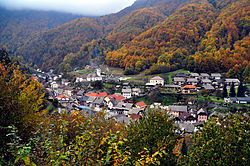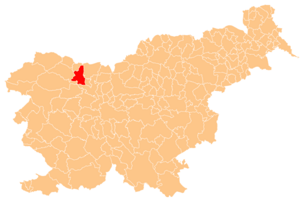
Cerknica is a town in the Karst region of southwestern Slovenia, with a population of 4,018. It is the seat of the Municipality of Cerknica. It belongs to the traditional region of Inner Carniola.

Brestanica is an urban settlement in the Municipality of Krško in eastern Slovenia. It lies in the valley at the confluence of the Sava River with a minor tributary called the Brestanica. The area was traditionally part of Styria. It is now included with the rest of the municipality in the Lower Sava Statistical Region.

Železniki is a small town in Slovenia. It is the seat of the Municipality of Železniki and it is the economic centre and the largest settlement in the Selca Valley. It includes the hamlets of Jesenovec, Gorenji Konec, Ovčja Vas, Trnje, Racovnik, Škovine, Na Kresu, Češnjica, Log, and Tolar.

Avče is a settlement on the left bank of the Soča River in the Municipality of Kanal in the Littoral region of Slovenia. It includes the hamlets of Dolnji Avšček, Gor(e)nji Avšček, and Langa along Avšček Creek southeast of the main settlement, Nadavče to the west, and Spodnji Log and Vrtače to the north along the railroad.

Podgorje is a settlement that is a now a suburb of the town of Kamnik in the Upper Carniola region of Slovenia.

Topol pri Medvodah is a small settlement in the Municipality of Medvode in the Upper Carniola region of Slovenia. It lies in the hills northwest of the Slovene capital Ljubljana and is a popular destination for short trips with locals.
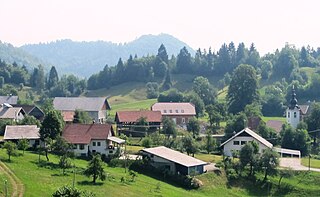
Butajnova is a village in the Municipality of Dobrova–Polhov Gradec in the Upper Carniola region of Slovenia. It is surrounded by Hrib Hill to the west and Prevalca Hill to the east. Butajnova itself is on a plateau that gradually rises to Klešč Hill to the northeast and descends to the valley of Little Creek to the west, south, and east. The village includes the hamlets of Ljubljanica, Kucelj, Roženija, Mala Vas, and Kurja Vas, part of which also belongs to the neighboring settlement of Šentjošt nad Horjulom.
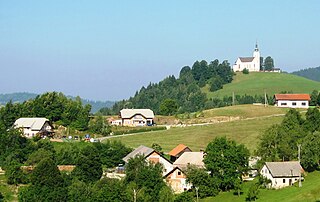
Črni Vrh is a dispersed settlement in the hills northwest of Polhov Gradec in the Municipality of Dobrova–Polhov Gradec in the Upper Carniola region of Slovenia. It includes many isolated farms scattered throughout the hills between Big Božna Creek to the south, Little Božna Creek to the northeast, Dog Plateau to the northwest, and Špilj Hill to the south-southeast.

Gabrje is a settlement north of Dobrova in the Municipality of Dobrova–Polhov Gradec in the Upper Carniola region of Slovenia. It also comprises the hamlets of Jarčji Potok, Knapovec, Pod Kotom, Ravnik, and Žerovnik. The settlement includes three creeks—from west to east, Žerovnik Creek, Jarc Creek, and Ostrožnik Creek—all tributaries of the Gradaščica River.

Dolsko is a settlement northeast of Ljubljana in the Municipality of Dol pri Ljubljani in the Upper Carniola region of Slovenia.

Povir is a village in the Municipality of Sežana in the Littoral region of Slovenia. It includes the hamlets of Britof, Dulanja Vas, and Guranja Vas.

Črni Vrh is a settlement in the hills south of Idrija in the traditional Littoral region of Slovenia. It includes the hamlets of Zgornja Vas, Spodnja Vas, Trate, Trebče, and Zidiše.

Lipsenj is a small village between Žerovnica and Gorenje Jezero on the eastern edge of Lake Cerknica in the Municipality of Cerknica in the Inner Carniola region of Slovenia. In addition to the main settlement, it includes the hamlets of Sveti Štefan and Podšteberk.

Gotenica is a settlement in the Municipality of Kočevje in southern Slovenia. The area is part of the traditional region of Lower Carniola and is now included in the Southeast Slovenia Statistical Region.

Zajčje Polje is a settlement in the Municipality of Kočevje in southern Slovenia. It was inhabited mostly by Gottschee Germans. The area is part of the traditional region of Lower Carniola and is now included in the Southeast Slovenia Statistical Region.

Rašica is a village north of Velike Lašče in central Slovenia. The area is part of the traditional region of Lower Carniola and is now included in the Central Slovenia Statistical Region.
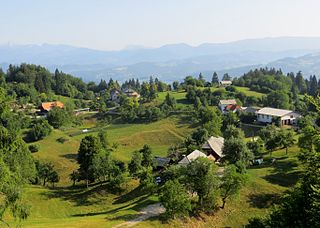
Katarija is a settlement in the hills south of Moravče in central Slovenia. Traditionally the area was part of Upper Carniola. It is now included with the rest of the Municipality of Moravče in the Central Slovenia Statistical Region. In addition to the main settlement, it includes the hamlets of Vrh Svetega Miklavža and Grmače.

Črešnjice is a settlement in the Municipality of Vojnik in eastern Slovenia. The area was traditionally part of the Styria region. It is now included with the rest of the municipality in the Savinja Statistical Region.
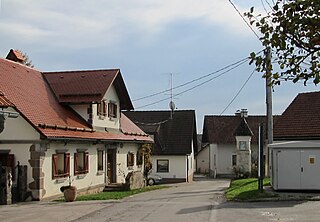
Zgornja Slivnica is a settlement in the Municipality of Grosuplje in central Slovenia. It lies in the hills north of Grosuplje and northeast of Šmarje-Sap and south of Mali Lipoglav in the historical region of Lower Carniola. The municipality is now included in the Central Slovenia Statistical Region.

Dobračeva is a formerly independent settlement in the town of Žiri in western Slovenia. It was part of the traditional region of Upper Carniola and is now included with the rest of the municipality in the Upper Carniola Statistical Region. It includes the hamlets of Koče and Rakulk.
